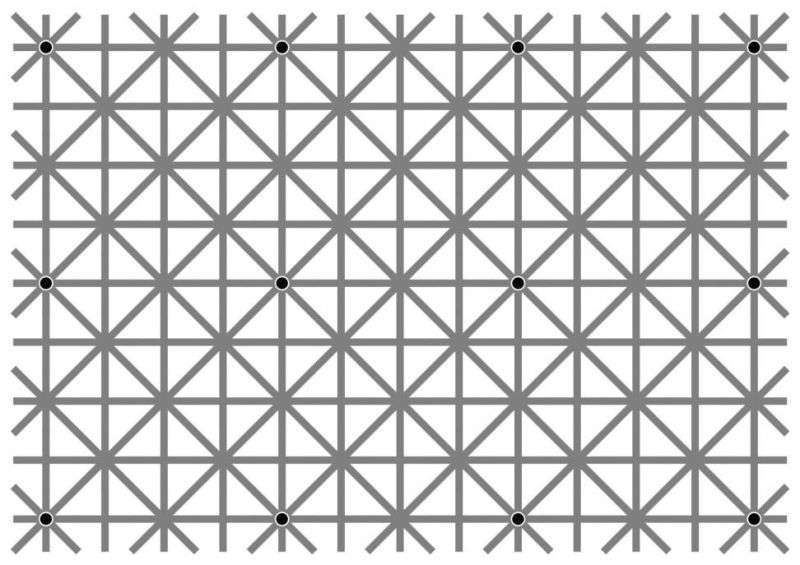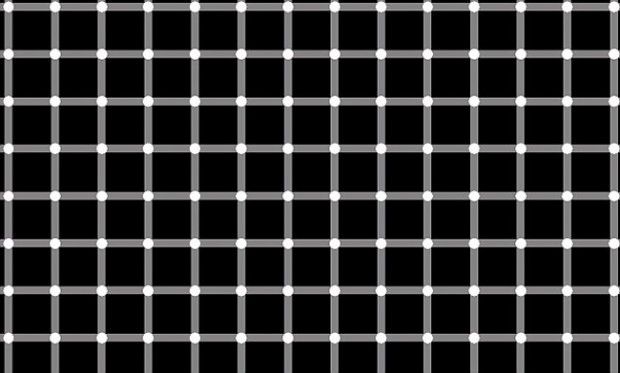Install the app
How to install the app on iOS
Follow along with the video below to see how to install our site as a web app on your home screen.
Note: This feature may not be available in some browsers.
-
After 15+ years, we've made a big change: Android Forums is now Early Bird Club. Learn more here.
You are using an out of date browser. It may not display this or other websites correctly.
You should upgrade or use an alternative browser.
You should upgrade or use an alternative browser.
Optical Illusions
- Thread starter dontpanicbobby
- Start date
D
Deleted User
Guest
No, not possible.
A six pack is my limit.
D
Deleted User
Guest
I thought I found a way to cheat by changing the zoom level.... but I still can't get anywhere close
Is that what you call 'thinking out of the box'?

D
Deleted User
Guest
I think if you change the color of the dots.. to say Yellow.
it might help to add a few more into view.
but everyone has blind spots... and a few will always be missing
It's because the eye has a very small area of maximum focus. Outside this becomes peripheral vision.
There's only one blind spot AFAIK, that's where the optic nerve enters the eye.
I think the above is correct, if I remember my school biology lessons. I always found eyes fascinating. To me it's a wonderful part of human anatomy. I would have liked to be an optician

What truly trips me out about this one is that it seems like the dots are flashing on and off in a random pattern. I can't think of many more where movement is seen in a static image.
They will stay static if you keep your sight fixed on one dot - but then you won't see many (or any) others.What truly trips me out about this one is that it seems like the dots are flashing on and off in a random pattern. I can't think of many more where movement is seen in a static image.
I assume that the flashing on and off is related to how we scan the image. When looking at a scene we don't gaze steadily, but rather our eyes scan around to point the fovea (the small point of maximum acuity that @LV426 mentioned) at points of interest. The eyes move in rapid jerks (saccades, if you want to look it up) that we aren't aware of, but I reckon that the different spots are flashing on and off as our eyes flicker from one part of the image to another.
If so, the only way you could see all 12 would be if you held the image far enough away that the whole thing was covered by the fovea - an my guess is that if you do that few if any would have the acuity to resolve the dots...
If you just gaze at the pic you can see six.. or at least I can see six. If I move my gaze I lose a row of dots to the left or right.
basic 101 user
Android Enthusiast
I'm asking here, not telling A few thoughts come to mind.
A few thoughts come to mind.
I think certainly, the blind spot where the optic nerve joins the retina must be part of the trick, as pointed out above.......But what role do the grid lines play in the illusion? Enhance it, or entirely essential for it to work?
 A few thoughts come to mind.
A few thoughts come to mind.I think certainly, the blind spot where the optic nerve joins the retina must be part of the trick, as pointed out above.......But what role do the grid lines play in the illusion? Enhance it, or entirely essential for it to work?
If I lay out 12 dots that size and print it on white paper, at roughly the same scale and distance....... I can see all 12, all day long. I'm too lazy to start adding in progressively more elements of the lattice work to see what happens, when the illusion really kicks in........but definitely curious.
Also, how would it be if each of the black dots did not have the white halo around it? Again, does that white ring enhance the illusion, or is it essential to it?
I imagine we are all looking at this on some form of flat panel TFT/LCD display, with a refresh rate; I suppose many of you are viewing it on smaller devices, but still see the same effect, regardless. My particular device a 15" laptop display, arms length away. Looking at it from an oblique angle has definite effect on the illusion, significantly different effects depending on which direction it is viewed from. Looking "down" from the "top edge" allows me to see all 12 quite readily, while "up from below" gives an entirely different appearance. High angles left and right also yield dramatically different effects; A technique which has proven very valuable when retouching photographs; When you think you're doing pretty well, almost finished and ready to "submit your work"; Have a look from the far left and right, see what leaps out at you. Particularly when doing black and white images, "left" angle offset reveals black/ dark issues, right angles reveal problems with white regions.
Also, how would it be if each of the black dots did not have the white halo around it? Again, does that white ring enhance the illusion, or is it essential to it?
I imagine we are all looking at this on some form of flat panel TFT/LCD display, with a refresh rate; I suppose many of you are viewing it on smaller devices, but still see the same effect, regardless. My particular device a 15" laptop display, arms length away. Looking at it from an oblique angle has definite effect on the illusion, significantly different effects depending on which direction it is viewed from. Looking "down" from the "top edge" allows me to see all 12 quite readily, while "up from below" gives an entirely different appearance. High angles left and right also yield dramatically different effects; A technique which has proven very valuable when retouching photographs; When you think you're doing pretty well, almost finished and ready to "submit your work"; Have a look from the far left and right, see what leaps out at you. Particularly when doing black and white images, "left" angle offset reveals black/ dark issues, right angles reveal problems with white regions.

D
Deleted User
Guest
I'm asking here, not tellingA few thoughts come to mind.
I think certainly, the blind spot where the optic nerve joins the retina must be part of the trick, as pointed out above.......But what role do the grid lines play in the illusion? Enhance it, or entirely essential for it to work?
If I lay out 12 dots that size and print it on white paper, at roughly the same scale and distance....... I can see all 12, all day long. I'm too lazy to start adding in progressively more elements of the lattice work to see what happens, when the illusion really kicks in........but definitely curious.
Also, how would it be if each of the black dots did not have the white halo around it? Again, does that white ring enhance the illusion, or is it essential to it?
I imagine we are all looking at this on some form of flat panel TFT/LCD display, with a refresh rate; I suppose many of you are viewing it on smaller devices, but still see the same effect, regardless. My particular device a 15" laptop display, arms length away. Looking at it from an oblique angle has definite effect on the illusion, significantly different effects depending on which direction it is viewed from. Looking "down" from the "top edge" allows me to see all 12 quite readily, while "up from below" gives an entirely different appearance. High angles left and right also yield dramatically different effects; A technique which has proven very valuable when retouching photographs; When you think you're doing pretty well, almost finished and ready to "submit your work"; Have a look from the far left and right, see what leaps out at you. Particularly when doing black and white images, "left" angle offset reveals black/ dark issues, right angles reveal problems with white regions.
Interesting that you can see all 12 without the grid.
I reckon that your peripheral vision (i.e. outside the fovea area) can't distinguish between the lines and dots. But when you remove the lines, then the peripheral vision, although blurry, can see the black dots.
basic 101 user
Android Enthusiast
I imagine everyone has done the "floating sausage" thing? (Oh, grow up, you "deplorable" lot!!!!)

Sorry it's such a lousy shot, it hardly does the piece justice. It's mostly glossy black, in a semi-permanent plexi enclosure; Not the easiest subject for this monkey's skills.


With both eyes open, bring your index fingers together in the horizontal plane, about four inches in front of your eyes; When fingertips are about 3/4 inch apart (That's about 20MM, for you fancy, elitist snobs. 
 ) the illusion works best. Obviously, a combination of blind spot and binocular/stereo vision, the angles created when viewing a subject a particular distance from the focal plane. Alternately opening and closing each eye partly deconstructs / explains the effect......Doing the same does not appear to affect the OP's illusion in the same way. Hmmmmm.
) the illusion works best. Obviously, a combination of blind spot and binocular/stereo vision, the angles created when viewing a subject a particular distance from the focal plane. Alternately opening and closing each eye partly deconstructs / explains the effect......Doing the same does not appear to affect the OP's illusion in the same way. Hmmmmm.
Many years ago, my father did an exhibition of work by Jim Pomeroy, in his gallery. I was given the following piece as a small child.
Stereo photography has obviously been around for over 100 years, this guy just added a small twist; To stock images, he added elements of collage and meticulous alignment (prior to availability of digital manipulation techniques). "Red Carpet On The Moon" was given to me as a small child, one of several Pomeroys in the family. When viewed through the glasses and at the right distance, the images fall into crisp register, and the red element leaps out of the frame, toward the viewer; As does the reflected image in (Armstrong's?) visor.

Prohibitions against multiple postings aside, who here will be surprised if there is more blah, blah, blah to follow, in LV 426's thread "Is it Art?"

 ) the illusion works best. Obviously, a combination of blind spot and binocular/stereo vision, the angles created when viewing a subject a particular distance from the focal plane. Alternately opening and closing each eye partly deconstructs / explains the effect......Doing the same does not appear to affect the OP's illusion in the same way. Hmmmmm.
) the illusion works best. Obviously, a combination of blind spot and binocular/stereo vision, the angles created when viewing a subject a particular distance from the focal plane. Alternately opening and closing each eye partly deconstructs / explains the effect......Doing the same does not appear to affect the OP's illusion in the same way. Hmmmmm.Many years ago, my father did an exhibition of work by Jim Pomeroy, in his gallery. I was given the following piece as a small child.
Stereo photography has obviously been around for over 100 years, this guy just added a small twist; To stock images, he added elements of collage and meticulous alignment (prior to availability of digital manipulation techniques). "Red Carpet On The Moon" was given to me as a small child, one of several Pomeroys in the family. When viewed through the glasses and at the right distance, the images fall into crisp register, and the red element leaps out of the frame, toward the viewer; As does the reflected image in (Armstrong's?) visor.

Prohibitions against multiple postings aside, who here will be surprised if there is more blah, blah, blah to follow, in LV 426's thread "Is it Art?"


It certainly depends on the contrast between the grid lines and the dots: I tried varying this (selecting by colour then filling with different shades) and if I make the lines too pale the illusion goes away. Also if I make the grid bright green I have no problems seeing them all, but with a deep red the illusion is still there, though less extreme.Interesting that you can see all 12 without the grid.
I reckon that your peripheral vision (i.e. outside the fovea area) can't distinguish between the lines and dots. But when you remove the lines, then the peripheral vision, although blurry, can see the black dots.
^^^You need to shift to landscape for this one.^^^
basic 101 user
Android Enthusiast
In the 6'th grade, I did a class report on optical illusions, "sampled" a dozen or so other kids in the class, got their reactions to 5 or 8 "classic" illusions.
It was a ridiculously flawed experiment, and mostly "cut and pasted" from an old issue of Popular Science.......But I was 12, gimmie' a break; And this simple illusion was one of the ones I remember fondly.
(Grammar of the text, notwithstanding)

It was a ridiculously flawed experiment, and mostly "cut and pasted" from an old issue of Popular Science.......But I was 12, gimmie' a break; And this simple illusion was one of the ones I remember fondly.
(Grammar of the text, notwithstanding)




